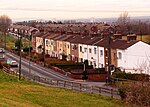Middlesbrough South and East Cleveland (UK Parliament constituency)
Constituencies of the Parliament of the United Kingdom established in 1997Pages with disabled graphsParliamentary constituencies in North East EnglandPolitics of MiddlesbroughUse British English from September 2013

Middlesbrough South and East Cleveland is a constituency created in 1997 represented in the House of Commons of the UK Parliament since 2017 by Simon Clarke of the Conservative Party.
Excerpt from the Wikipedia article Middlesbrough South and East Cleveland (UK Parliament constituency) (License: CC BY-SA 3.0, Authors, Images).Middlesbrough South and East Cleveland (UK Parliament constituency)
Geographical coordinates (GPS) Address Nearby Places Show on map
Geographical coordinates (GPS)
| Latitude | Longitude |
|---|---|
| N 54.54 ° | E -1.139 ° |
Address
Morton Grange
TS7 0PE
England, United Kingdom
Open on Google Maps








